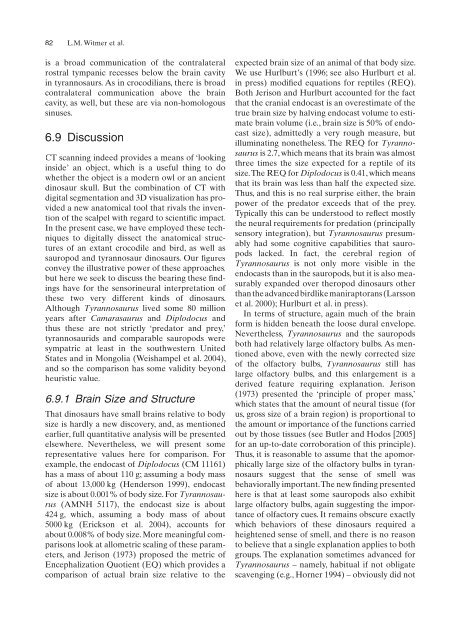Witmer, L. M., R. C. Ridgely, D. L. Dufeau, and M. C.
Witmer, L. M., R. C. Ridgely, D. L. Dufeau, and M. C.
Witmer, L. M., R. C. Ridgely, D. L. Dufeau, and M. C.
You also want an ePaper? Increase the reach of your titles
YUMPU automatically turns print PDFs into web optimized ePapers that Google loves.
82 L.M. <strong>Witmer</strong> et al.<br />
is a broad communication of the contralateral<br />
rostral tympanic recesses below the brain cavity<br />
in tyrannosaurs. As in crocodilians, there is broad<br />
contralateral communication above the brain<br />
cavity, as well, but these are via non-homologous<br />
sinuses.<br />
6.9 Discussion<br />
CT scanning indeed provides a means of ‘looking<br />
inside’ an object, which is a useful thing to do<br />
whether the object is a modern owl or an ancient<br />
dinosaur skull. But the combination of CT with<br />
digital segmentation <strong>and</strong> 3D visualization has provided<br />
a new anatomical tool that rivals the inven-<br />
tion of the scalpel with regard to scientific fi impact.<br />
In the present case, we have employed these techniques<br />
to digitally dissect the anatomical structures<br />
of an extant crocodile <strong>and</strong> bird, as well as<br />
sauropod <strong>and</strong> tyrannosaur dinosaurs. Our fifigures<br />
convey the illustrative power of these approaches,<br />
but here we seek to discuss the bearing these findfi ings have for the sensorineural interpretation of<br />
these two very different kinds of dinosaurs.<br />
Although Tyrannosaurus lived some 80 million<br />
years after Camarasaurus <strong>and</strong> Diplodocus <strong>and</strong><br />
thus these are not strictly ‘predator <strong>and</strong> prey,’<br />
tyrannosaurids <strong>and</strong> comparable sauropods were<br />
sympatric at least in the southwestern United<br />
States <strong>and</strong> in Mongolia (Weishampel et al. 2004),<br />
<strong>and</strong> so the comparison has some validity beyond<br />
heuristic value.<br />
6.9.1 Brain Size <strong>and</strong> Structure<br />
That dinosaurs have small brains relative to body<br />
size is hardly a new discovery, <strong>and</strong>, as mentioned<br />
earlier, full quantitative analysis will be presented<br />
elsewhere. Nevertheless, we will present some<br />
representative values here for comparison. For<br />
example, the endocast of Diplodocus (CM 11161)<br />
has a mass of about 110 g; assuming a body mass<br />
of about 13,000 kg (Henderson 1999), endocast<br />
size is about 0.001% of body size. For Tyrannosaurus<br />
(AMNH 5117), the endocast size is about<br />
424 g, which, assuming a body mass of about<br />
5000 kg (Erickson et al. 2004), accounts for<br />
about 0.008% of body size. More meaningful comparisons<br />
look at allometric scaling of these parameters,<br />
<strong>and</strong> Jerison (1973) proposed the metric of<br />
Encephalization Quotient (EQ) which provides a<br />
comparison of actual brain size relative to the<br />
expected brain size of an animal of that body size.<br />
We use Hurlburt’s (1996; see also Hurlburt et al.<br />
in press) modified fi equations for reptiles (REQ).<br />
Both Jerison <strong>and</strong> Hurlburt accounted for the fact<br />
that the cranial endocast is an overestimate of the<br />
true brain size by halving endocast volume to estimate<br />
brain volume (i.e., brain size is 50% of endocast<br />
size), admittedly a very rough measure, but<br />
illuminating nonetheless. The REQ for Tyrannosaurus<br />
is 2.7, which means that its brain was almost<br />
three times the size expected for a reptile of its<br />
size. The REQ for Diplodocus is 0.41, which means<br />
that its brain was less than half the expected size.<br />
Thus, <strong>and</strong> this is no real surprise either, the brain<br />
power of the predator exceeds that of the prey.<br />
Typically this can be understood to refl flect<br />
mostly<br />
the neural requirements for predation (principally<br />
sensory integration), but Tyrannosaurus presumably<br />
had some cognitive capabilities that sauropods<br />
lacked. In fact, the cerebral region of<br />
Tyrannosaurus is not only more visible in the<br />
endocasts than in the sauropods, but it is also measurably<br />
exp<strong>and</strong>ed over theropod dinosaurs other<br />
than the advanced birdlike maniraptorans (Larsson<br />
et al. 2000); Hurlburt et al. in press).<br />
In terms of structure, again much of the brain<br />
form is hidden beneath the loose dural envelope.<br />
Nevertheless, Tyrannosaurus <strong>and</strong> the sauropods<br />
both had relatively large olfactory bulbs. As mentioned<br />
above, even with the newly corrected size<br />
of the olfactory bulbs, Tyrannosaurus still has<br />
large olfactory bulbs, <strong>and</strong> this enlargement is a<br />
derived feature requiring explanation. Jerison<br />
(1973) presented the ‘principle of proper mass,’<br />
which states that the amount of neural tissue (for<br />
us, gross size of a brain region) is proportional to<br />
the amount or importance of the functions carried<br />
out by those tissues (see Butler <strong>and</strong> Hodos [2005]<br />
for an up-to-date corroboration of this principle).<br />
Thus, it is reasonable to assume that the apomorphically<br />
large size of the olfactory bulbs in tyrannosaurs<br />
suggest that the sense of smell was<br />
behaviorally important. The new fi finding<br />
presented<br />
here is that at least some sauropods also exhibit<br />
large olfactory bulbs, again suggesting the importance<br />
of olfactory cues. It remains obscure exactly<br />
which behaviors of these dinosaurs required a<br />
heightened sense of smell, <strong>and</strong> there is no reason<br />
to believe that a single explanation applies to both<br />
groups. The explanation sometimes advanced for<br />
Tyrannosaurus – namely, habitual if not obligate<br />
scavenging (e.g., Horner 1994) – obviously did not

















